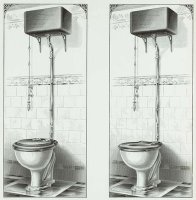The flush toilet, as we know it today, has become an essential fixture in households around the world. However, in the early 1900s, the introduction and widespread adoption of this modern convenience marked a significant leap in sanitation and public health. The flush toilet revolutionized the way people managed human waste, improving hygiene standards, and mitigating the spread of diseases.
Prior to the widespread use of flush toilets, sanitation practices were far from ideal. Chamber pots and outhouses were commonly used, but they presented numerous health hazards. The accumulation of human waste in these confined spaces led to foul odors, the attraction of disease-carrying insects and rodents, and the contamination of groundwater and drinking water sources. This created a breeding ground for bacteria and parasites, which contributed to the spread of diseases such as cholera, dysentery, and typhoid fever.
The development of the flush toilet provided a solution to these sanitation challenges. The concept of a flush toilet can be traced back to ancient civilizations, but it wasn't until the 19th century that significant advancements were made. In the early 1900s, flush toilets started to gain popularity, particularly in urban areas where the need for improved sanitation was most pressing.
The flush toilet works by using water to carry away waste from a bowl or pan to a sewage system or septic tank. The introduction of a water-flushing mechanism replaced the need for manual removal of waste, significantly reducing the risks associated with handling and storing human excreta. With the push of a lever or pull of a chain, the water swiftly flushed the waste away, ensuring a more sanitary and hygienic environment.
The early flush toilets featured a simple design consisting of a water tank or cistern positioned above the bowl. When the user activated the flush mechanism, water from the tank rapidly filled the bowl, creating a forceful flow that expelled the waste through an S-shaped pipe and into the sewer system. This innovative design prevented foul odors from escaping back into the bathroom, thanks to the water seal in the pipe.
The introduction of the flush toilet in the early 1900s brought about a transformative shift in public health. The improved sanitation conditions resulted in a significant reduction in waterborne diseases, lowering mortality rates and improving overall well-being. Furthermore, the elimination of open waste disposal systems contributed to the cleanliness and aesthetics of urban areas, enhancing the quality of life for city dwellers.
As the 20th century progressed, the flush toilet became more prevalent, gradually replacing older, less hygienic sanitation practices. Its adoption was facilitated by the growing infrastructure for water supply and sewage systems. The accessibility and convenience of flush toilets also played a role in their widespread acceptance, as they became more affordable and available to a larger segment of the population.
Today, the flush toilet is considered a standard feature in households, and its impact on public health cannot be overstated. While modern advancements have brought about additional improvements, such as low-flow toilets and water-saving mechanisms, the fundamental principles of the flush toilet remain the same. The early 1900s marked a crucial turning point in the history of sanitation, as the introduction of the flush toilet laid the foundation for improved public health and hygiene standards that we continue to benefit from today.
